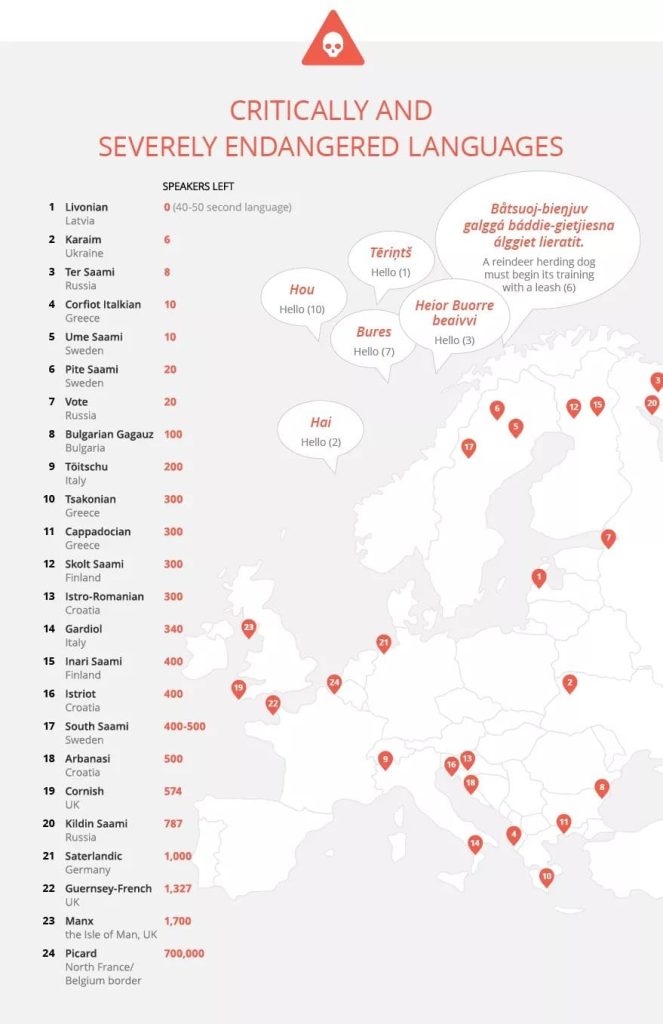December 28, 2019 – Croatia regularly makes top 20 lists around the world, from football to tourism. But did you know is it is also in the top 20 list of most endangered languages no less than 3 times? Meet Istriot, Arbanasi and Istro-Romanian, spoken by just 1200 people combined.
It is a sad reality that many traditions and much cultural heritage is dying out around the world, as the traditions of the older generations are embraced less and less by the younger generations in this modern, digital era. Among the things being lost is language. Globalisation has played its part in the rise of languages such as English, while at the same time local languages are not taken up as much by the young, and so many languages have become extinct. Indeed today there are some 7,111 languages around the world, but just 23 languages account for half of the world’s population, and some 40% of languages today are endangered, many with less than 1,000 native speakers remaining.

On the list of the most critically endangered, I was surprised to find which country featured the most – Croatia. No less than three languages spoken in Croatia which are in danger of extinction – Istriot, Arbanasi and Istro-Romanian. While I had heard of Istro-Romanian (why else would the world’s first vampire, Jure Grande, come from Istria…), the other two were new to me, and I decided to look into things with a little research.
And this being the Balkans, baby, it didn’t take me long to learn that Nikola Tesla was not a Serb at all apparently, but had Romanian roots and was an Istro-Romanian speaker… But let’s not veer off topic.
Let’s begin with Istriot.
https://www.youtube.com/watch?v=FpFdo_z9I1U
Istriot is a Romance language spoken by about 400 people in the southwestern part of the Istrian peninsula in Croatia, particularly in Rovinj and Vodnjan. It should not be confused with the Istrian dialect of the Venetian language. It is a Romance language related to the Ladin populations of the Alps. Its exact classification has long been unclear, but in 2017, the Max Planck Institute for the Science of Human History with the Dalmatian language in the Dalmatian Romance subgroup.
Historically, its speakers never referred to it as “Istriot”; it had six names after the six towns where it was spoken. In Vodnjan it was named “Bumbaro”, in Bale “Vallese”, in Rovinj “Rovignese”, in Šišan “Sissanese”, in Fažana “Fasanese” and in Galižana “Gallesanese”. The term Istriot was coined by the 19th-century Italian linguist Graziadio Isaia Ascoli.
Similiar in the geography of its speakers is Istro-Romanian, a Balkan Romance language, which is still spoken in a few villages and hamlets on the Istrian peninsula. While its speakers call themselves Rumeri, Rumeni, they are also known as Vlachs, Rumunski, Ćići and Ćiribiri. The last two, used by ethnic Croats, originated as a disparaging nickname for the language, rather than its speakers.
And could it be that the most famous speaker of Istro-Romanian was the most famous inventor of them all? Romanian inventor Henri Coanda seemed to think so…
a scientist who was personally acquainted with Tesla, said he had a neo-Latin appearance and did not looked like a slav (in fact Nicola Tesla in the picture above looks like a typical Venetian citizen, as many I have known myself with very similar appearance in the Veneto). Coanda even wrote that Tesla spoke in “Istro-Romanian”: I invite the reader to read http://istro-romanian.com/news/1999_0111tesla-rom.htm (unfortunately in Romanian) about this language knowledge. How could Nicola Tesla speak a language (the Istro-Romanian) that was not taught in school in those years and that was only spoken by a few thousands people in Istria and in nearby Lika? Of course, only if he had learned it from his family as a child.
Moving further down the coast to Zadar and a third endangered language, whose roots are Albanian via Montenegro – Arbanasi.
Originally Albanian Catholics from Skhoder in northern Albania, the Arbanasi fled to Croatia with the help of the Archbishop of Bar between 1726 and 1733, eventually setting in the Zadar region, where they have remained ever since. They no longer see themselves as Albanians, but as Arbanas Croatians.
Due to the fact that there has been a long history of interaction with other tribes and nations, there are many external influences on the Arbanasi language today. Originally based on a unique Gheg Albanian dialect, the years have embraced influences from Croatian, Italian and Venetian, and there are many loan words in the language today. Additionally, a large number of Chakavian speakers settled among them and left their influence. Back in 2016, an initiative was launched to keep Arbanasi alive in one school in Zadar.
Are you a speaker of Istriot, Arbanasi or Istro-Romanian? We would love to hear from you and feature your story and language in more detail on TCN. Contact us at news@total-croatia-news.com Subject Rare language.
But perhaps there is something even linguistically rarer than these three languages in Croatia – foreigners who speak Croatian well. A look at 25 of the most common mistakes foreigners make when learning Croatian.











